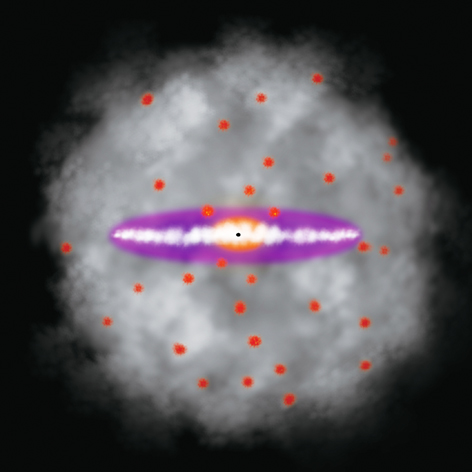
Schematic of the Milky Way showing the dark matter halo (gray), globular clusters (red circles), the thick disk (dark purple), the stellar disk (white), the stellar bulge (red-orange), and the central black hole. The stellar disk is about 100,000 light years in diameter, while the dark halo extends to a diameter of at least 600,000 light years. (Credit: NASA/CXC/M.Weiss)
Using data from the Large Sky Area Multi-Object Fiber Spectroscopic Telescope (LAMOST) near Beijing, Dr. XING Qianfan and Dr. ZHAO Gang from the National Astronomical Observatories, Chinese Academy of Sciences (NAOC) analyzed the Mg abundances of F- and G-type dwarf stars and found evidence for accreted component in the Galactic thick disc. These accreted stars have relatively low Mg abundances with high orbital eccentricities and high maximum Galactocentricradii, providing more evidence for a gas-rich merger origin of the Galactic thick disc.
The presence of thick stellar disc in the Milky Way has been established for decades, but the dominant formation mechanism of the thick disc is still unclear. For instance, the radial migration scenario suggests that the thick disc is created from stars migrating outward from the inner part of the disc. Models of disc heating, meanwhile, propose that the thick disc is composed of stars heated by minor mergers of satellites. In the accretion scenario, stars from infalling dwarf galaxies compose the thick disc.
Then gas-rich merger models suggest that the accretion of a gas-rich merger results in the formation of the thick disc. For stars originated from dwarf galaxies, their formation involves both accretion and gas-rich merger models, but the proportion of accreted stars and stars formed in-situ is different in two models.
It is important to determine the role played by accreted stars in the formation of the thick disc. XING and ZHAO investigated the properties of the Galactic discs using F- and G-type dwarfs with distances and proper motions. They assigned the sample stars into different stellar populations using kinematic criteria and separated the thin disc from the thick one at a relatively low-density region of [Mg/Fe]. Compared to the thin disc, the thick disk is composed of metal-poor and alpha-enriched stars, indicating the thick-disc stars are born earlier than most thin-disc stars. They also found a few metal-poor stars with the kinematics of the thick disc to possess relatively low [Mg/Fe]. These stars do not follow the general [Mg/Fe] trend of the thick disk and are chemically similar to stars in satellite dwarf galaxies. Their large apogalactic distance and orbital eccentricity allow them to reach positions far away from the Galactic center, suggesting they were formed in dwarf galaxies and confined to the thick disc after the accretion events.
According to their study, the existence of accreted component in the thick disc confirmed the contribution from the dwarf galaxies for the formation of the thick disc. However, the proportion of accreted stars is relatively small in contrast with thick-disc stars formed in-situ—far below the prediction of the accreted model. Composed primarily of stars formed in-situ, the thick disc possesses a few of stars accreted from dwarf galaxies, in consistent with the gas-rich merger models. Moreover, the distribution of eccentricities in the thick disc is in good agreement with the gas-rich merger models.

